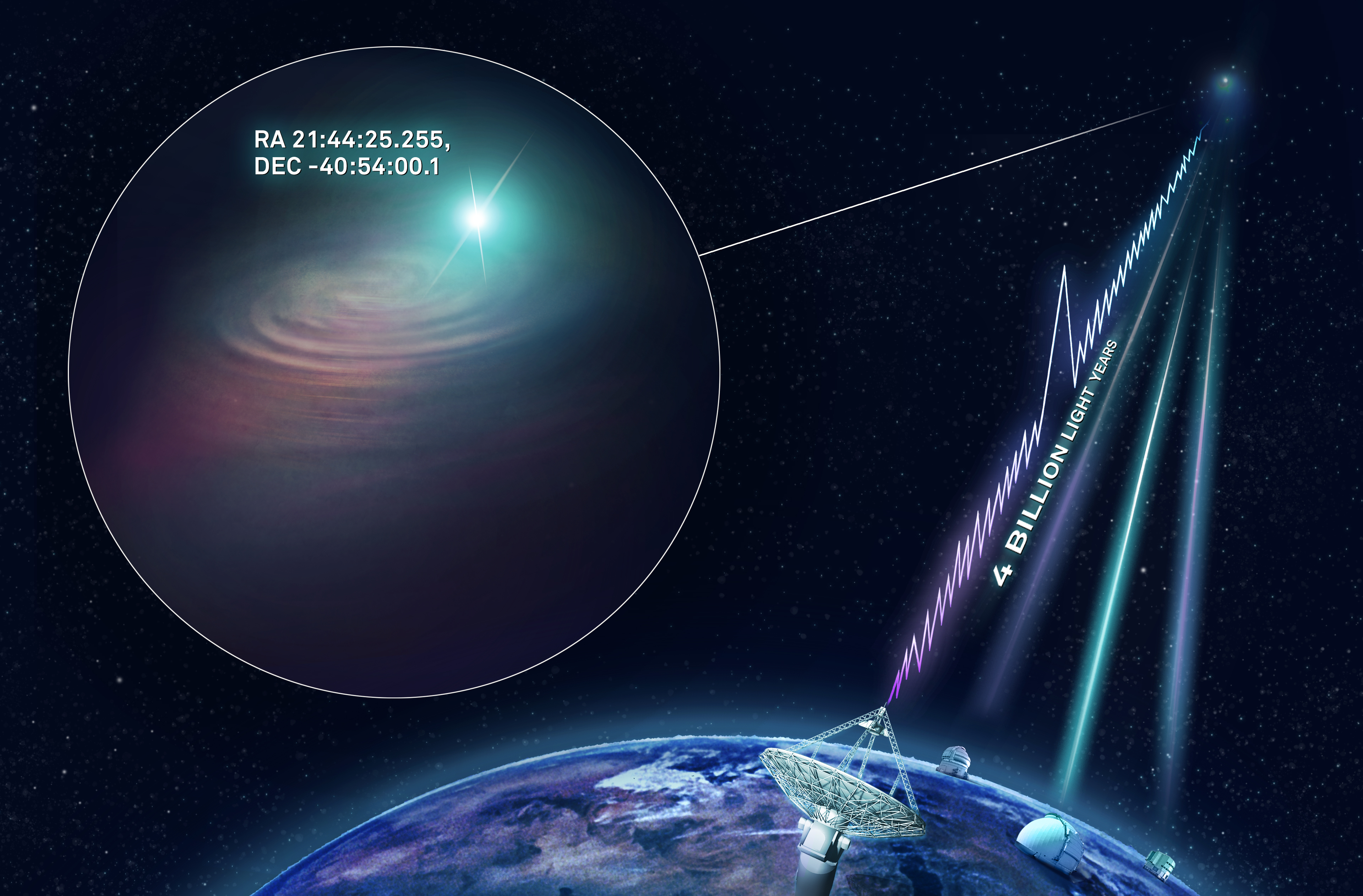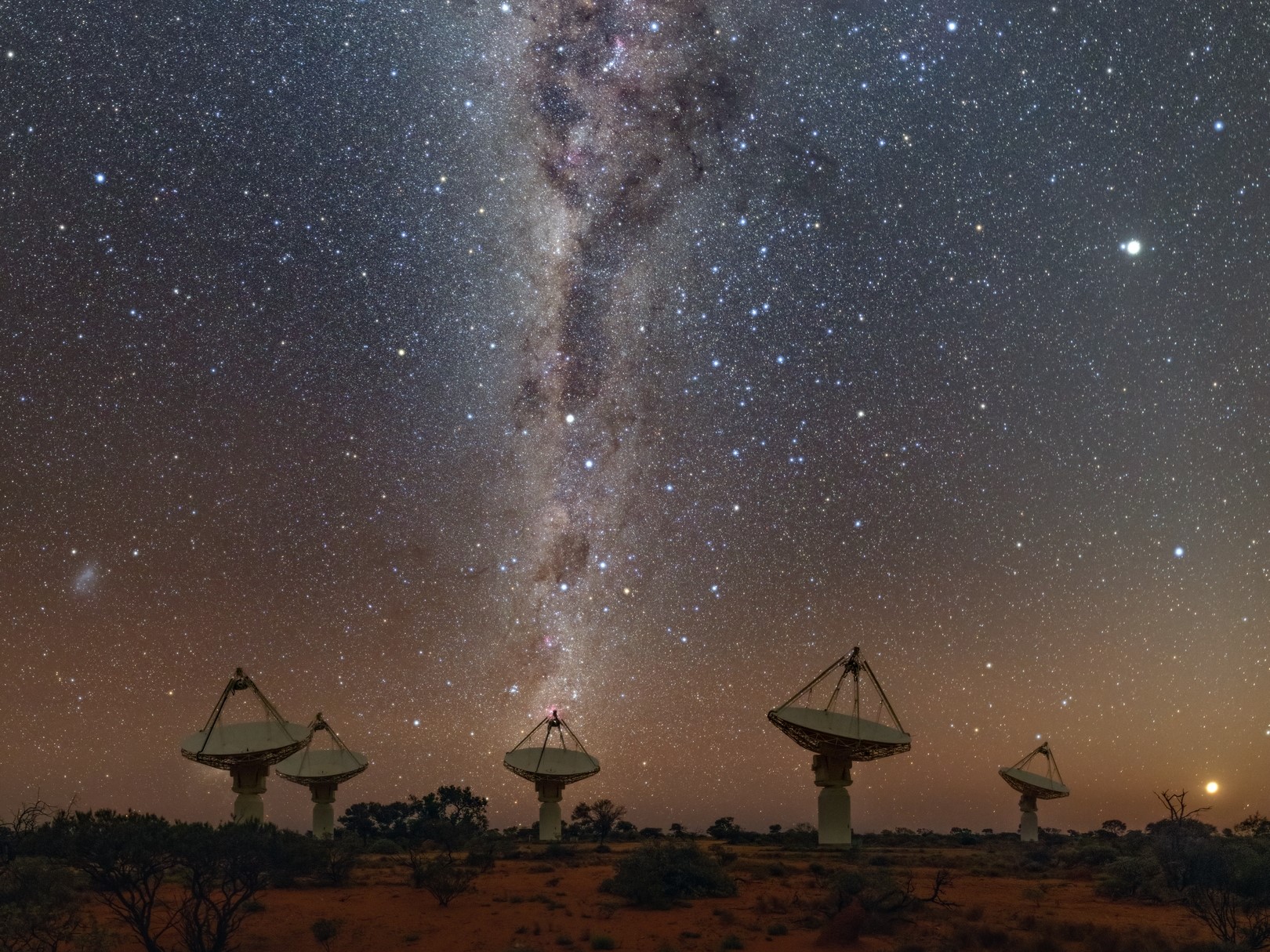
Artist’s impression of CSIRO’s Australian SKA Pathfinder (ASKAP) radio telescope finding a fast radio burst and determining its precise location. The KECK, VLT and Gemini South optical telescopes joined ASKAP with follow-up observations to image the host galaxy. Credit: CSIRO/Dr Andrew Howells
Have you ever looked up to the stars and wondered what’s out there?
The Universe presents so many questions. And an international team of astronomers has just found something that could lead to some answers. Using our new ASKAP radio telescope in remote Western Australia, they’ve managed to locate the origin of a mysterious fast radio burst.
With their super-sleuthing skills, the team has discovered that the burst – known as FRB180924 – occurred in a relatively large galaxy. The galaxy is the same size and mass of our own Milky Way galaxy. And it’s about 3.6 billion light years away in the constellation Grus.
This is the first time that a one-off burst has been pinpointed to a precise location in the Universe. It brings us closer to figuring out what is causing the bursts.
Fast radio bursts: an astronomical ‘whodunnit’
We’re always pumped when our team and collaborators make new astronomical discoveries. So you can imagine how excited we are about having located a burst.
Bursts are ‘blink and you’ll miss them’ events, lasting for less than a millisecond. They’re rare but powerful flashes of radio waves. They release about the same amount of energy in a millisecond that our Sun emits in 80 years. Most of them are one-off events but some can ‘burst’ again at the same spot in the sky.
They’re a mysterious part of astronomy because no one really knows when or where these bursts will happen, or what causes them.
There are many theories being floated to explain the bursts. Could they be two dense stars merging together, or exploding stars? Or maybe a black hole and neutron star colliding (thanks Muse)? Thanks to ASKAP, we’re starting to piece together the clues.
Sherlock ASKAP to the rescue
FRBs are elusive: only 85 have been detected since they were first found in 2007.
We still don’t know what causes them but to figure this out, we need to know where they’re coming from. To capture this information, researchers using ASKAP built a customised instrument that can freeze the telescope’s data stream when a burst is detected. It’s like being able to find a speck of gold in a waterfall.
The team set the system to work and within hours FRB180924 was detected.
The new technology stopped the search and immediately downloaded a snippet of raw data. This was used to generate a high-resolution map and pinpoint the FRB’s position in the wider Universe with a precision of 1/50,000th of a degree!

The Milky Way galaxy stretches above the core group of antennas that make up our ASKAP radio telescope Credit: CSIRO/Alex Cherney
We now have iron-clad proof that FRBs originate billions of light years away, beyond our own galaxy.
When another burst – known as FRB121102 or ‘The Repeater’ – was found in 2017 it was pinpointed to a small galaxy that is forming lots of stars. But our new radio burst friend and its host galaxy look nothing like The Repeater and its host galaxy. This tells us they can be produced in a variety of environments. It also suggests that repeating and non-repeating bursts are different.
What’s next in the fast radio burst story?
This is the third chapter in the FRB ‘whodunnit’ series. Without this chapter, we don’t have enough data to write the next. Hopefully soon, we’ll be able to write the final, and most important, chapter – what causes fast radio bursts?
We’ll keep using ASKAP to find more bursts and uncover their cosmic addresses. And then start looking for similarities that will help determine their cause. And who knows what other discoveries we’ll make along the way?
The localisation of the burst was done as part of a project using ASKAP called CRAFT (Commensal Real-time ASKAP Fast Transients), a collaboration between CSIRO, Curtin University, Macquarie University, Swinburne University of Technology, University of California, Santa Cruz, USA, and Pontificia Universidad Catolica de Valparaiso, Chile.
We acknowledge the Wajarri Yamaji as the traditional owners of the Murchison Radio-astronomy Observatory site.


22nd July 2019 at 9:27 pm
That wonderful picture of the antennas with what looks at first sight as the milky way funnelling Into one of them reminded me at once of Fred Hoyle’s early classic sci-fi story The Black Cloud.
22nd July 2019 at 5:17 pm
What does the spectrum look like?
29th July 2019 at 9:06 am
Hi Erik,
We asked Keith Bannister, one of the principal engineers in this story and he said: “The spectrum is “patchy” i.e. across the band there are some bright patches and some faint ones.”
Hope that helps visualise it!
Kind regards,
Kashmi
CSIRO Social Media Team
22nd July 2019 at 3:59 pm
Congratulations you clever people!
Tell how on earth do you conceptualise and then build something that has never been built before? How do you do it?
Sorry about all the questions.
29th July 2019 at 9:08 am
Hi Shazz, not at all!
We asked Keith Bannister, one of the principal engineers in this story. He said to conceptualise it, “you start by thinking what you’d like to do (e.g. localise a millisecond-duration burst of radio waves) then think about what you need: you need to know it’s happened, and then do some magic when it does. After that, it’s solving a lot of tricky engineering.”
Hope that helps!
Kind regards,
Kashmi
CSIRO Social Media Team